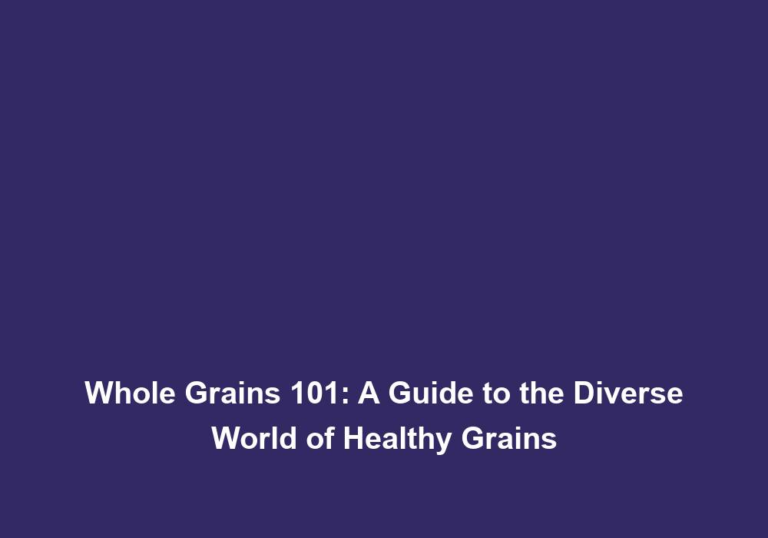Grains for Gains: A Journey Through Nutrient-Rich Whole Grains
In today’s fast-paced world, maintaining a healthy and balanced diet is more important than ever. While many food options may tempt us with their convenience and taste, it is essential to prioritize nutrient-rich whole grains to fuel our bodies and promote overall well-being. In this article, we will embark on a journey through the world of whole grains, exploring their benefits, varieties, and tips for incorporating them into your daily diet.
What are Whole Grains?
Whole grains are unrefined grains that contain all parts of the grain kernel – the bran, germ, and endosperm. Unlike refined grains, which are processed to remove the bran and germ, whole grains retain their natural goodness and provide a rich source of essential nutrients, including fiber, vitamins, minerals, and antioxidants.
Whole grains come in various forms, such as wheat, rice, oats, barley, quinoa, buckwheat, and millet. Each type of whole grain offers its unique set of nutritional benefits and flavors. They are versatile ingredients that can be incorporated into a wide range of dishes, from breakfast cereals and salads to soups, stews, and side dishes.
The Benefits of Whole Grains
Incorporating whole grains into your diet offers numerous benefits that can contribute to a healthier lifestyle. Let’s explore some key advantages:
- Rich in Fiber: Whole grains are an excellent source of dietary fiber, which aids in digestion, helps maintain a healthy weight, and promotes a feeling of fullness. The fiber content in whole grains also supports a healthy gut microbiome, which is crucial for overall well-being.
- Heart-Healthy: Research suggests that consuming whole grains can lower the risk of heart disease by reducing cholesterol levels and regulating blood pressure. The high fiber content and other heart-healthy components in whole grains, such as antioxidants and phytochemicals, contribute to their cardiovascular benefits.
- Improved Digestion: The high fiber content in whole grains promotes regular bowel movements and prevents constipation, contributing to a healthy digestive system. Additionally, the combination of fiber and other nutrients in whole grains supports the growth of beneficial gut bacteria, which further enhances digestion.
- Stable Blood Sugar Levels: Whole grains have a lower glycemic index compared to refined grains, meaning they cause a slower and more gradual rise in blood sugar levels. This characteristic is particularly beneficial for individuals with diabetes or those looking to manage their blood sugar levels. The fiber in whole grains also helps regulate insulin response.
- Packed with Nutrients: Whole grains contain essential vitamins and minerals such as B vitamins, iron, magnesium, and zinc, which are vital for maintaining overall health and well-being. These nutrients play essential roles in energy production, immune function, and the maintenance of healthy skin, hair, and nails.
- Weight Management: The fiber content in whole grains helps control appetite and manage weight by providing a longer-lasting feeling of satisfaction. Whole grains are typically less calorie-dense compared to refined grains, making them a great choice for those looking to maintain or lose weight while still feeling satisfied.
- Reduced Risk of Chronic Diseases: Regular consumption of whole grains has been associated with a lower risk of developing chronic conditions such as type 2 diabetes, certain cancers, and obesity. The combination of fiber, antioxidants, and other bioactive compounds in whole grains contributes to their protective effects against these diseases.
Types of Whole Grains
There is a wide variety of whole grains available, each offering its unique set of nutritional benefits and flavors. Here are some popular whole grains you can consider incorporating into your diet:
- Quinoa: Quinoa is a versatile grain that is gluten-free and high in protein, making it an excellent choice for vegetarians and individuals with gluten intolerance. It is also a good source of fiber, magnesium, and phosphorus.
- Brown Rice: Brown rice is a less processed version of white rice, retaining the bran and germ, which provides fiber and essential nutrients. It has a nutty flavor and pairs well with various dishes. Brown rice is a good source of manganese and selenium.
- Oats: Oats are a great source of soluble fiber and can be enjoyed as oatmeal, added to smoothies, or used in baking recipes. They also contain beta-glucan, a type of fiber known for its cholesterol-lowering effects, as well as magnesium and phosphorus.
- Barley: Barley is a nutritious grain with a chewy texture and a slightly nutty taste. It can be used in soups, stews, salads, or even as a rice substitute. Barley is rich in fiber, selenium, and manganese.
- Buckwheat: Despite its name, buckwheat is not related to wheat and is naturally gluten-free. It is rich in antioxidants and can be used in pancakes, porridge, or as a flour substitute in baking. Buckwheat is a good source of magnesium, copper, and manganese.
- Whole Wheat: Whole wheat is a staple grain consumed in various forms, including bread, pasta, and cereals. It is a great source of fiber and nutrients when consumed in its whole form. Whole wheat contains B vitamins, iron, zinc, and magnesium.
- Millet: Millet is a gluten-free grain that provides a good source of protein, fiber, and essential minerals. It can be used in pilafs, salads, or as a substitute for rice or couscous. Millet is rich in magnesium, phosphorus, and manganese.
Tips for Incorporating Whole Grains into Your Diet
Now that we have explored the benefits and varieties of whole grains, here are some practical tips to help you incorporate them into your daily diet:
- Start the Day with Whole Grains: Opt for whole grain cereals, oatmeal, or whole wheat toast for a nourishing and satisfying breakfast. You can also try adding cooked quinoa, millet, or barley to your breakfast bowl for added texture and nutrients.
- Choose Whole Grain Snacks: Replace refined grain snacks with healthier alternatives such as air-popped popcorn, whole grain crackers, or homemade granola bars. These snacks provide a satisfying crunch while delivering the benefits of whole grains.
- Experiment with Different Grains: Try different whole grains such as quinoa, barley, or millet in your salads, soups, and side dishes to add variety and enhance nutritional value. Mix them with fresh vegetables, herbs, and a flavorful dressing for a delicious and wholesome meal.
- Read Food Labels: When purchasing packaged foods, check the ingredient list to ensure whole grains are listed as one of the main ingredients. Look for terms like “whole wheat,” “whole oats,” or “brown rice” to ensure you are choosing truly whole grain products.
- Cook in Bulk: Prepare larger quantities of whole grains and store them in the refrigerator for quick and easy meal preparation throughout the week. Having cooked grains on hand allows you to easily incorporate them into salads, stir-fries, or grain bowls.
- Whole Grains as Side Dishes: Replace refined grains with whole grains as side dishes for your main meals. For example, choose brown rice instead of white rice or whole wheat pasta instead of regular pasta. This simple swap increases the fiber and nutrient content of your meals.
- Combine with Fresh Produce: Pair whole grains with an assortment of colorful fruits and vegetables to create nutrient-dense meals that are both delicious and satisfying. Add cooked quinoa to a salad with fresh greens, tomatoes, cucumbers, and avocado for a well-rounded and flavorful dish.
In conclusion, incorporating nutrient-rich whole grains into your diet can significantly contribute to your overall health and well-being. With their abundance of fiber, vitamins, minerals, and other beneficial compounds, whole grains provide a solid foundation for a balanced and wholesome eating plan. So, embark on the journey of discovering various whole grains and enjoy the wide array of flavors and nutritional benefits they offer. Start making small changes today, and reap the rewards of a healthier future.







